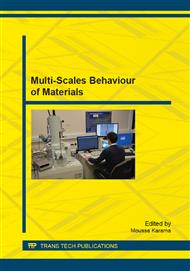[1]
F. Costanzo and L. Gray; Multiscale Modeling and Simulation of Composite Materials andStructures: Chapter 5: A Micromechanics-Based Notion of Stress for Use in the Determination of Continuum-Level Mechanical Properties via Molecular Dynamics; Springer Science (2008).
DOI: 10.1007/978-0-387-68556-4_5
Google Scholar
[2]
P. Boisse and Gilles Hivet: Consistent mesoscopic mechanical behaviour model for woven composite reinforcements in biaxial tension Composites: Part B 39 (2008) 345–361.
DOI: 10.1016/j.compositesb.2007.01.011
Google Scholar
[3]
Gilles Hivet, Consistent 3d geometrical model of fabric elementary cell. application to a meshing preprocessor for 3d finite element analysis, Finite Elements in Analysis and Design 42 (2005) 25–49.
DOI: 10.1016/j.finel.2005.05.001
Google Scholar
[4]
L. Orgéas: Woven fabric permeability: From textile deformation to fluid flow mesoscale simulations, Composites Science and Technology 68 (2008) 1624–1630.
DOI: 10.1016/j.compscitech.2008.02.027
Google Scholar
[5]
Jinhuo Wang: Predictive Modeling and Experimental Measurement of Composite Forming Behavior: Thesis submitted to The University of Nottingham for the degree of Doctor of Philosophy; (2008).
Google Scholar
[6]
P. Boisse: Computational determination of in-plane shear mechanical behavior of textile composite reinforcements, Computational Materials Science 40 (2007) 439–448.
DOI: 10.1016/j.commatsci.2007.01.022
Google Scholar
[7]
P. Badel, S. Gauthier, E. Vidal-Sallé, P. Boisse: Rate constitutive equations for computational analyses of textile composite reinforcement mechanical behaviour during forming; Composites: Part A 40 (2009) 997–1007.
DOI: 10.1016/j.compositesa.2008.04.015
Google Scholar
[8]
Guillaume COUÉGNAT : Approche multiéchelle du comportement mécanique de matériaux composites à renfort tissé, thèse Université de Bordeaux 1- (2008).
Google Scholar
[9]
J. Molimard : Mécanique des Matériaux composites, EMSE Version 2 (2004).
Google Scholar
[10]
Faiza Ben Abdallah-Maamoun : Elaboration, caracterisation et modelisation d'un materiau composite à base d'une matrice thermoplastique renforcee par du liege, thèse ENIT (2009).
Google Scholar
[11]
A. Alzina: Multiscale modelling of thermal conductivity in composite materials for cryogenic structures, Composite Structures 74 (2006) 175–185.
DOI: 10.1016/j.compstruct.2005.04.002
Google Scholar
[12]
Jayesh R. Jain and Somnath Ghosh: Damage Evolution in Composites with a Homogenization-based Continuum Damage Mechanics Model; International Journal of Damage Mechanics (2009).
DOI: 10.1177/1056789508091563
Google Scholar
[13]
D. Trias: Random models versus periodic models for fibre reinforced composites, Computational Materials Science 38 (2006) 316–324.
DOI: 10.1016/j.commatsci.2006.03.005
Google Scholar
[14]
B. Van Den Broucke: Determination of the mechanical propreties of textile-reinforced composites taking into account textile forming parameters; Springer/ESAFORM (2010).
DOI: 10.1007/s12289-009-0680-9
Google Scholar
[15]
Moran Wang, Ning Pan: Elastic property of multiphase composites with random microstructures; Journal of Computational Physics 228 (2009) 5978–5988.
DOI: 10.1016/j.jcp.2009.05.007
Google Scholar
[16]
W. Voigt, Über die Beziehung zwischen den beiden Elastizitätskonstanten isotroper Köِrper, Wied. Ann. 38 (1889) 573–587.
DOI: 10.1002/andp.18892741206
Google Scholar
[17]
A. Reuss, Berechnung der Fliessgrenz von Mischkristallen auf Grund der Plastizitätsbedingung für Einkristalle, Z. Angew. Math. Mech. 9 (1929).
DOI: 10.1002/zamm.19290090104
Google Scholar


